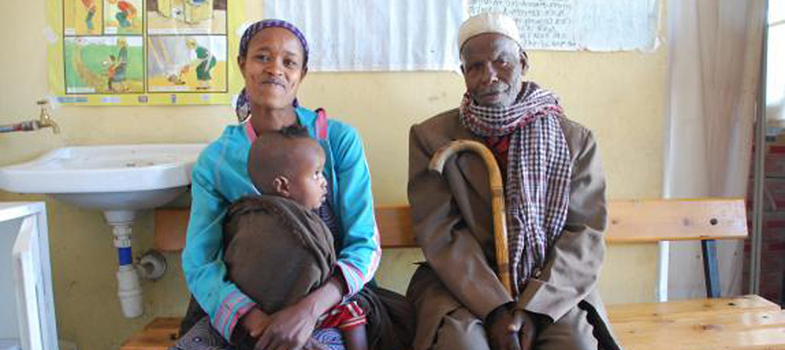Self-Assessment Questions (SAQs) for Study Session 10
Now that you have completed this study session, you can assess how well you have achieved its Learning Outcomes by answering the questions below. Write your answers in your Study Diary and discuss them with your Tutor at the next Study Support Meeting. You can check your answers with the Notes on the Self-Assessment Questions at the end of this Module.
First read Case Study 10.1 then answer the questions that follow it.
Case Study 10.1 Fatima
Fatima is a 16-year-old young woman who lives in Roda kebele. The health post in Roda kebele is just 30 minutes’ walk from Fatima’s home. Fatima is sexually active but wants to delay pregnancy until she reaches 20 years old and finishes school. She knows the health post in her vicinity provides reproductive health services including contraceptives. She doesn’t want to visit the health post at times when most adults will be there for services.
One day after school she went to the health post only to find it was closed. She tried on another day but this time the guard at the gate shouted at her, saying the services were not for school girls of her age. As she was in desperate need of contraceptives she tried once more to visit the facility but this time along with adult clients. She had to sit and wait a long time until all the adults had received services. The adults’ expressions were discouraging but she managed to get into the consultation room and told the health worker that she was in need of contraceptives. The health worker at the health post, without taking Fatima’s full history, said she was already exhausted and had to close the facility. In addition, she said contraceptives were not for girls of her age and asked her why she was sexually active at this age. The health worker has never been trained in adolescent- and youth-friendly reproductive health service provision. Fatima is married and is her husband’s third wife. But the health worker had no interest in exploring Fatima’s history.
SAQ 10.1 (tests Learning Outcomes 10.1, 10.2 and 10.3)
- a.Is Roda health post providing adolescent- and youth-friendly reproductive health services? If yes, explain why. If not, explain why not.
- b.What are the barriers to Fatima’s utilisation of RH services? Categorise them under individual, cultural/social and institutional factors.
Answer
- a.Roda Health Post is not providing AYFRH services. This is because of the following reasons:
- The health worker at the health post is not trained in adolescent and youth-friendly services and is not welcoming to and supportive of the access to RH information and services by young people.
- The health worker and the guard do not show respect for young people.
- The adults who were waiting for the services were not supportive. They did not seem to know that young people have the right to access health information and services.
- The health worker did not give enough time to Fatima.
- The service hours were not convenient for young people.
- b.Barriers to Fatima’s utilisation of RH Services
| Individual/personal factors | Cultural/social factors | Institutional factors |
|---|---|---|
Schooling status: she is a student who went to the health post with her school materials; the adults, the guard, and the health worker were judgemental based on their belief that a student who is ‘unmarried’ should not be sexually active and hence shouldn’t come to the health post. | Awareness level of the communities Attitudes towards young people’s sexual behaviour Attitude towards AYRH services | Judgemental health worker Space/locations: Fatima has to wait for the service with adults Timing: it was not convenient for Fatima |
First read Case Study 10.2 then answer the questions that follow it.
Case Study 10.2 Adane
Adane is an 18-year-old man who wants to get tested for HIV. He went to the nearest health post, which is an hour’s walk from his home. When he reached it he found that it did not provide a testing service. The health worker at the facility told him that she had no idea where he could get this service.
While he was at school discussing it with his peers, he learned that there was a health centre in town which provided the service, but it was about four hours walk from his home, i.e. an eight-hour round trip. He wanted to visit the health centre but had no money to pay for the transport.
SAQ 10.2 (tests Learning Outcomes 10.1, 10.2 and 10.3)
- a.What required standard is missing from this facility?
- b.What could be done to respond to the needs for HIV testing young people in Adane’s kebele?
Answer
- a.An appropriate referral linkage is the required standard that is missing. The health worker at the health post should have awareness of where a VCT service is available and be able to refer young people to it.
- b.As it is a long way for young people to go for a VCT the health centre could arrange an outreach service for Adane’s kebele and other distant kebeles in the health centre’s catchment areas.
SAQ 10.3 (tests Learning Outcomes 10.1 and 10.4)
A 17-year-old girl comes to the health post with a cough. Explain what other conditions you will assess her for in addition to the cough?
Answer
Even if she comes to the health post for health problems other than RH, you should assess her RH using the HEADS assessment. HEADS can be used to assess whether she is at risk from STIs (including HIV) or might become pregnant. You should also assess whether she abuses substances and/or is being sexually abused.
Summary of Study Session 10
